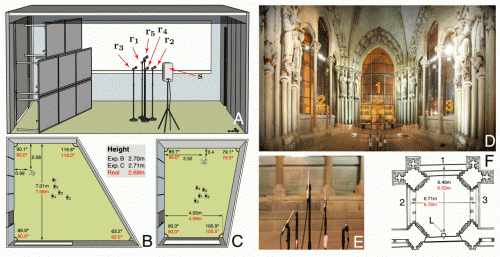Four microphones, computer algorithm enough to produce 3-D model of simple, convex room

Blind people sometimes develop the amazing ability to perceive the contours of the room they're in based only on auditory information. Bats and dolphins use the same echolocation technique for navigating in their environment.
At EPFL, a team from the Audiovisual Communications Laboratory (LCAV), under the direction of Professor Martin Vetterli, has developed a computer algorithm that can accomplish this from a sound that's picked up by four microphones. Their experiment is being published this week in the Proceedings of the National Academy of Sciences (PNAS). "Our software can build a 3D map of a simple, convex room with a precision of a few millimeters," explains PhD student Ivan Dokmanić.
Randomly placed microphones
As incredible as it may seem, the microphones don't need to be carefully placed. "Each microphone picks up the direct sound from the source, as well as the echoes arriving from various walls," Dokmanić continues. "The algorithm then compares the signal from each microphone. The infinitesimal lags that appear in the signals are used to calculate not only the distance between the microphones, but also the distance from each microphone to the walls and the sound source."
This ability to "sort out" the various echoes picked up by the microphones is in itself a first. By analyzing each echo's signal using "Euclidean distance matrices," the system can tell whether the echo is rebounding for the first or second time, and determine the unique "signature" of each of the walls.
The researchers tested the algorithm at EPFL using a "clean" sound source in an empty room in which they changed the position of a movable wall. Their results confirmed the validity of the approach. A second experiment carried out in a much more complex environment – an alcove in the Lausanne Cathedral – gave good partial results. New tests using more microphones are very likely to yield improved results.
Mobile localization in buildings
The team's initial conclusions already point to interesting potential applications. "Architects could use this to design rooms – for example concert halls or auditoriums – based upon the specific acoustics they would like to create," says Dokmanić.
Applications in forensic science are also on the horizon: based on several recordings of the same setup, audio waves could yield information on elements in the room that cannot be seen. In the same vein, analyzing a telephone call from a person who is moving around a room could allow investigators to identify where the person is calling from.
Finally, it might be possible to implement this algorithm in mobile devices and use them to deduce location information inside buildings – a place where GPS signals do not penetrate well. "There are already many applications, and we foresee many more. This is only the beginning!" concludes Dokmanić.
More information: Acoustic echoes reveal room shape, www.pnas.org/cgi/doi/10.1073/pnas.1221464110
Journal information: Proceedings of the National Academy of Sciences
Provided by Ecole Polytechnique Federale de Lausanne



















